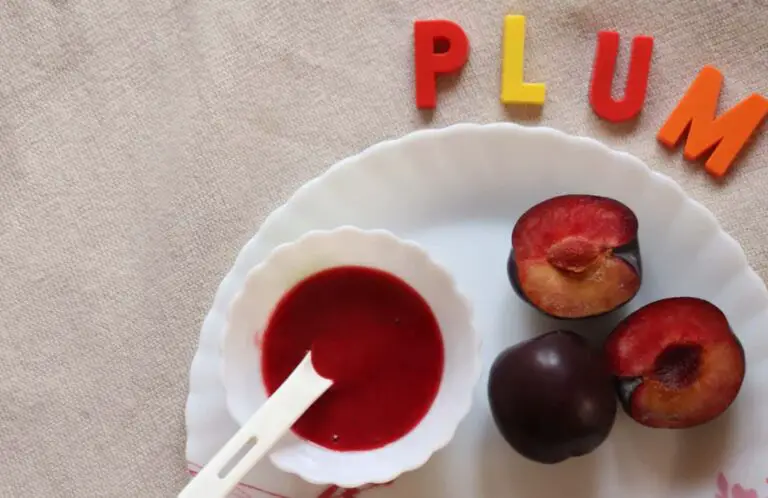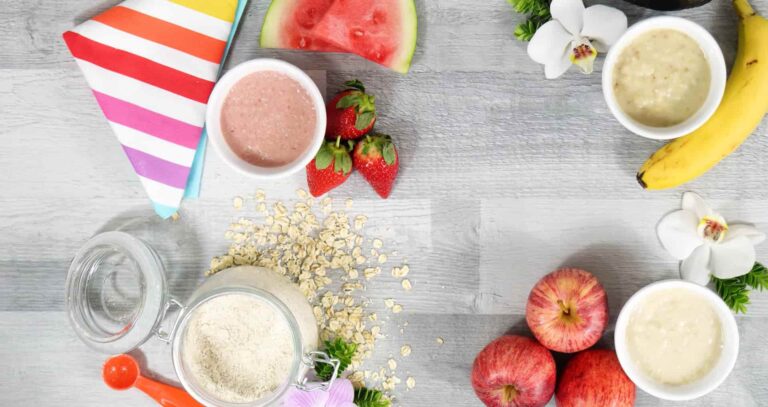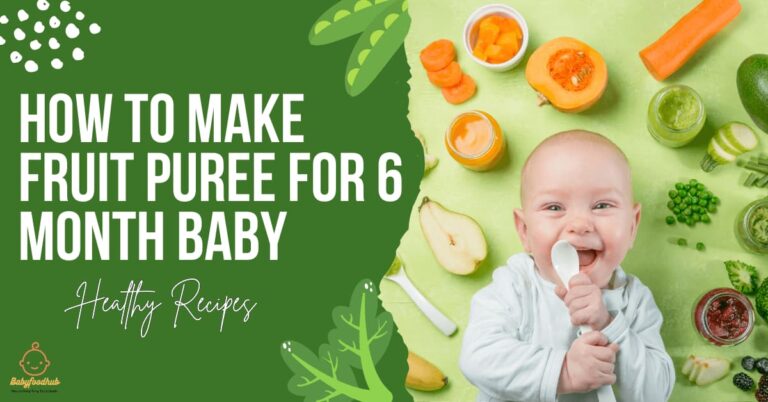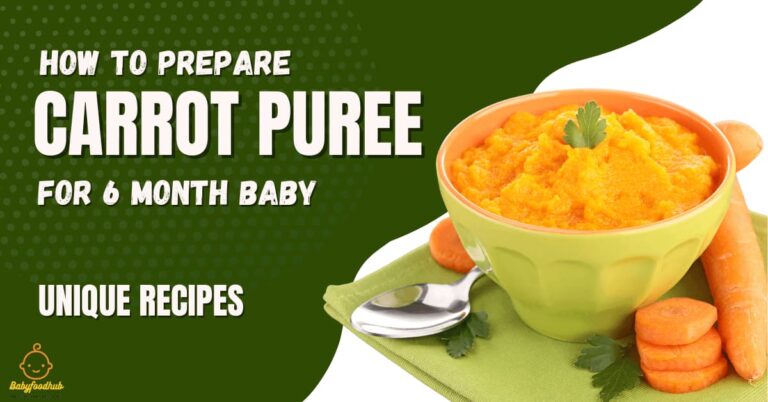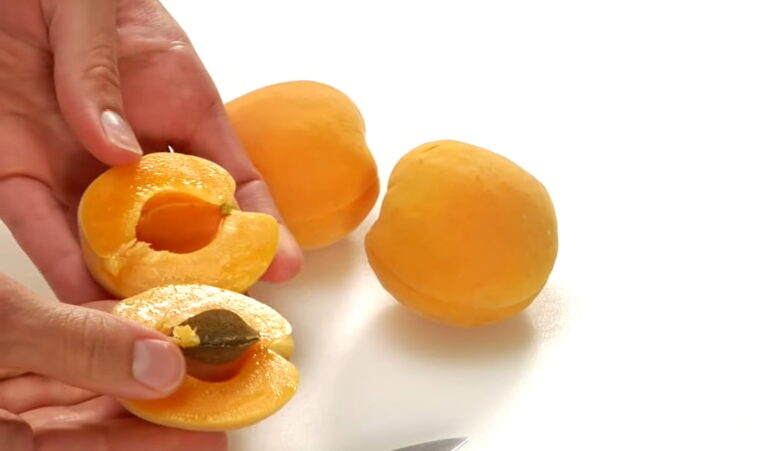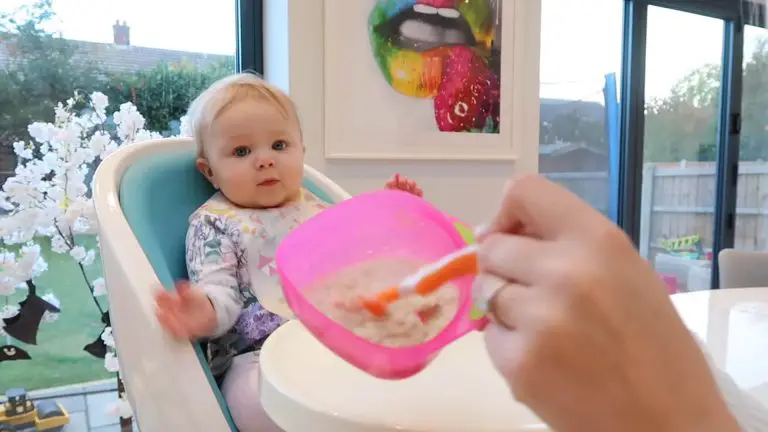How to make mango baby food
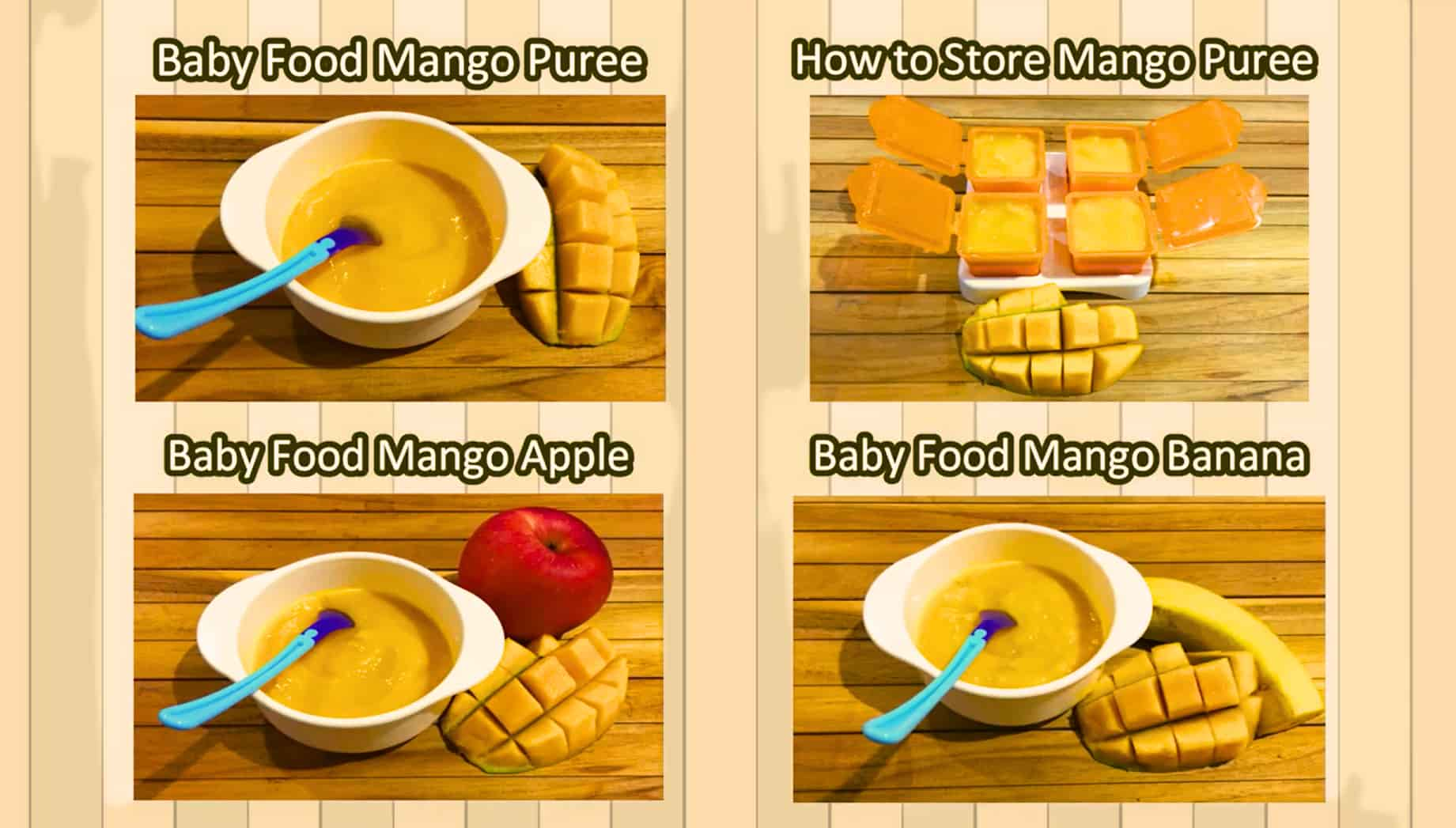
To make mango baby food, simply steam or bake the mango until soft, then puree it until smooth. Introducing solid foods to your baby’s diet is an exciting milestone, and mango is a nutritious and delicious option to consider.
Packed with essential vitamins and minerals, mangoes provide a sweet and tangy taste that babies often enjoy. The process of making mango baby food is both quick and easy. All you need to do is steam or bake the mango until it becomes soft and then puree it until it reaches a smooth consistency.
This allows your baby to experience the unique flavor and reap the many health benefits of this tropical fruit. We will guide you through the simple steps to create homemade mango baby food that your little one will love. So, let’s get started and discover how to make mango baby food at home.
The Nutritional Benefits Of Mango For Babies
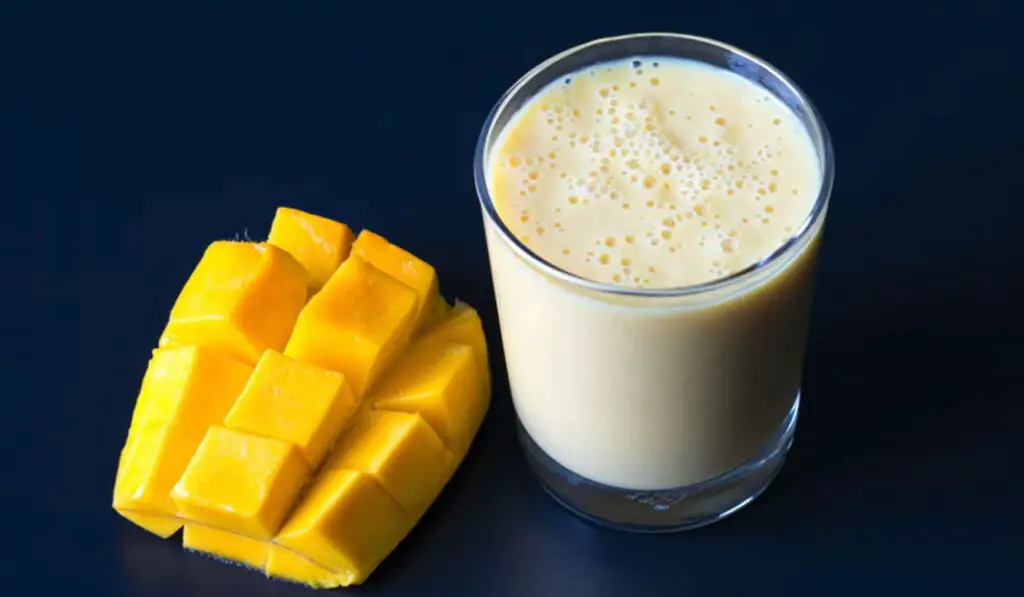
Mango baby food is packed with essential nutrients that are beneficial for the growth and development of infants. The sweet fruit is rich in vitamins A and C, as well as fiber, promoting a healthy digestive system and boosting the immune system.
Rich In Vitamins And Minerals:
Mangoes are packed with essential vitamins and minerals that benefit your baby’s growth and development.
- Vitamin C: Mangoes are an excellent source of Vitamin C, which helps boost your baby’s immune system and aids in the absorption of iron.
- Vitamin A: These fruity delights are rich in Vitamin A, promoting healthy eyesight and supporting your baby’s overall growth.
- Vitamin E: Mangoes contain Vitamin E, which helps protect your baby’s cells from damage and supports their healthy skin.
- Potassium: Mangoes are a great source of potassium, an essential mineral that supports the proper functioning of your baby’s muscles and nerves.
- Folate: Mangoes are also rich in folate, a B vitamin crucial for the development of your baby’s brain and spinal cord.
High In Dietary Fiber:
- Mangoes are high in dietary fiber, which is essential for the healthy functioning of your baby’s digestive system.
- Digestive Health: The fiber content in mangoes helps prevent constipation and promotes regular bowel movements in your little one.
- Satiety: The high fiber content of mangoes can help your baby feel fuller for longer, preventing overeating and promoting healthy weight management.
Antioxidant Properties:
- Mangoes possess powerful antioxidant properties that are beneficial to your baby’s health.
- Protection against Free Radicals: The antioxidants in mangoes neutralize harmful free radicals, protecting your baby’s cells from damage and promoting overall well-being.
- Eye Health: The antioxidants present in mangoes help protect your baby’s eyes and maintain their healthy vision.
- Immunity Boost: Mangoes’ antioxidant properties help strengthen your baby’s immune system, protecting them against common illnesses.
Remember, always consult your pediatrician before introducing any new foods to your baby’s diet. Enjoy the process of preparing delicious mango baby food while providing your little one with essential nutrients for healthy growth and development.
Selecting The Perfect Mangoes For Baby Food
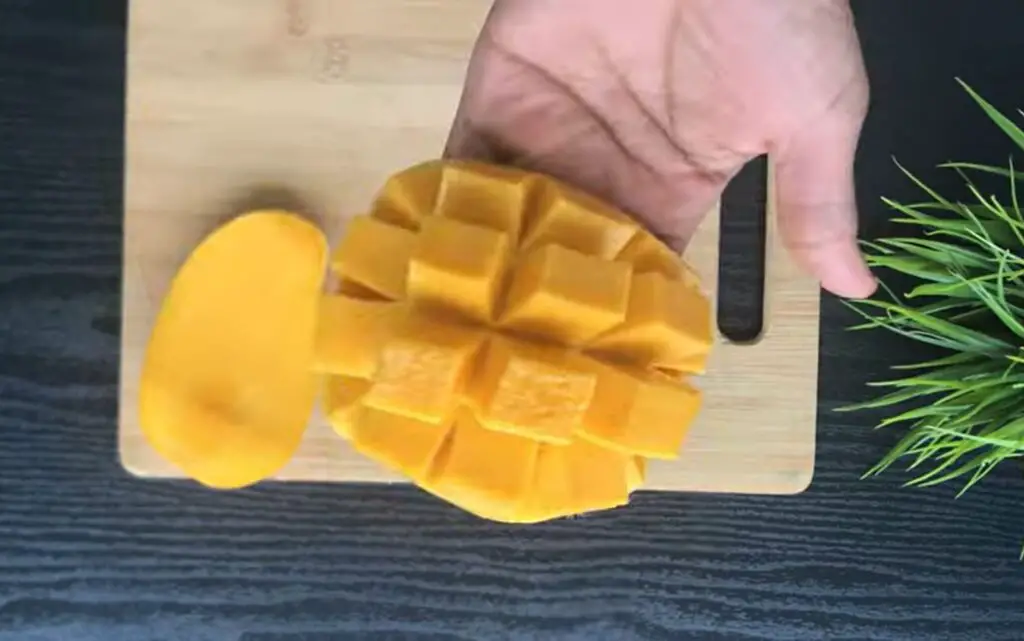
Discover the ultimate guide to choosing mangoes for homemade baby food. Learn simple tips for selecting the perfect ripe mangoes to create delicious and nutritious meals for your little one.
Choosing Ripe And Sweet Mangoes:
To create delicious and nutritious mango baby food, selecting the perfect mangoes is crucial. Here are some tips to help you choose ripe and sweet mangoes for your little one:
- Look for a vibrant color: Opt for mangoes that have a rich, vibrant color, such as orange, red, or yellow. This indicates that the mango is ripe and sweet.
- Assess the fragrance: Gently sniff the mango near the stem end. If it emits a fragrant and sweet aroma, it is a good indication that the mango is ripe and ready to eat.
- Feel the texture: Gently squeeze the mango to assess its firmness. Depending on your baby’s preference, you can choose a slightly firm mango for a more crunchy texture or a softer one for a smoother consistency.
- Check for blemishes: Examine the mango for any blemishes, dark spots, or mold. Avoid mangoes with these imperfections as they may affect the quality and taste of the baby food.
- Consider the variety: Different mango varieties have their own unique flavors and sweetness levels. Experiment with various types such as Alphonso, Kent, or Ataulfo to find the one that your little one enjoys the most.
- Organic options for baby food: When it comes to making baby food, using organic mangoes can provide added peace of mind. Organic mangoes are grown without the use of synthetic pesticides or fertilizers, making them a healthier option for your baby.
By following these tips, you can ensure that the mangoes you select for making baby food are ripe, sweet, and perfect for your little one’s taste buds.
Preparing Mangoes For Baby Food
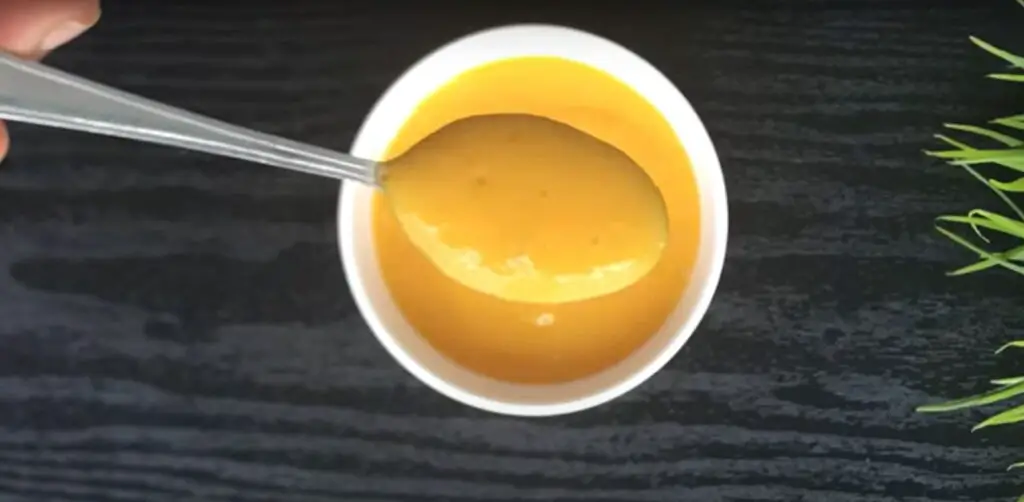
Learn how to prepare mangoes for homemade baby food with these simple steps. From selecting ripe mangoes to pureeing them to the perfect consistency, this guide will help you create a healthy and delicious treat for your little one.
Mangoes are a delicious and nutritious fruit that babies can enjoy when transitioning to solid foods. Before you can make mango baby food, it is important to properly prepare the mangoes. Follow these steps to wash, peel, and remove the pit from the mangoes, ensuring that the fruit is safe and ready for your little one to enjoy.
Washing And Peeling The Mangoes
- Start by rinsing the mangoes under cool running water to remove any dirt or residue.
- Gently rub the mangoes with your hands to ensure they are clean.
- Using a clean knife and cutting board, carefully slice off the stem end of the mango.
- Place the mango on one of the cut ends to create a stable base for peeling.
- With a vegetable peeler or a sharp knife, peel the skin of the mango from top to bottom, following the curve of the fruit.
- Continue peeling until the entire mango is free of skin.
Removing The Pit
- Hold the peeled mango upright on a cutting board.
- Use a sharp knife to slice along the seed, starting from the top and moving downward. Be cautious while doing this to avoid any injuries.
- Cut all the way around the pit until you have two mango halves.
- Taking one half at a time, cut the mango flesh into small cubes or slices, depending on the age and preferences of your baby.
- Repeat the process with the other mango half.
Now that you have successfully prepared the mangoes for baby food, you can use the ripe fruit to create delicious and nutritious purees, adding variety to your little one’s diet. Enjoy this exciting phase of introducing solid foods to your baby and relish the natural sweetness and health benefits of mangoes.
Cooking Mangoes For Baby Food
Learn how to make homemade mango baby food with this easy recipe. Cooking mangoes for your little one is a nutritious and delicious way to introduce new flavors.
Mangoes are not only delicious, but they also make a perfect option for homemade baby food. By cooking mangoes before pureeing, you can ensure that the texture and consistency are suitable for your little one. Here are two methods for cooking mangoes for baby food: steaming and boiling.
Steaming Or Boiling The Mangoes:
- Steaming the mangoes:
- Peel and remove the pit from the mangoes.
- Cut the mangoes into small pieces.
- Place the mango pieces in a steamer basket over boiling water.
- Cover and steam for about 5-7 minutes, or until the mangoes are tender.
- Check the mangoes with a fork to ensure they are soft enough for blending.
- Remove the mangoes from the steamer and let them cool before pureeing.
Boiling the mangoes:
- Peel and remove the pit from the mangoes.
- Cut the mangoes into small pieces.
- Place the mango pieces in a saucepan and cover them with water.
- Bring the water to a boil and then reduce the heat to a simmer.
- Cook the mangoes for about 10-15 minutes, or until they are soft and tender.
- Drain the mangoes and let them cool before pureeing.
Cooking the mangoes through steaming or boiling ensures that they are soft and easily digestible for your baby. Once the mangoes have been cooked, they are ready to be pureed using a blender.
Using A Blender To Puree The Cooked Mangoes:
- Prepare the cooked mangoes by placing them in a blender.
- Blend the mangoes on low speed to start, gradually increasing the speed until the puree is smooth and creamy.
- If needed, add a small amount of water or breast milk to achieve the desired consistency.
- Continue blending until the puree is free of any lumps.
- Once the puree is smooth, transfer it to a storage container or ice cube trays if you prefer freezing small portions for later use.
- Store the mango puree in the refrigerator for up to three days or freeze it for up to three months.
Using a blender allows you to create a silky and easily manageable texture for your little one. Remember to introduce new foods gradually and consult with your child’s pediatrician to ensure a safe and healthy transition to solids.
Now that you know how to cook mangoes for baby food and puree them using a blender, it’s time to embark on this delicious and nutritious journey for your baby’s taste buds. Enjoy exploring the wonderful world of homemade mango baby food!
Beginner-Friendly Mango Baby Food Recipes
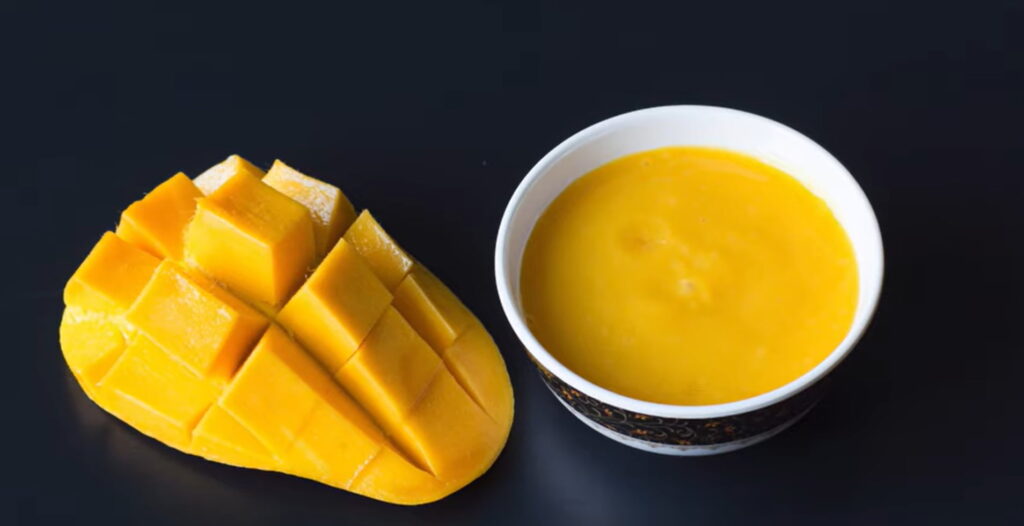
Discover a range of beginner-friendly mango baby food recipes that will teach you how to make delicious and nutritious meals for your little one. These easy-to-follow recipes are perfect for introducing your baby to the sweet and tropical flavors of mango.
Are you looking to introduce your little one to the delightful taste of mangoes? Look no further! Below are three easy and beginner-friendly mango baby food recipes that are sure to please your little foodie. From a simple mango puree to a delicious mango and banana mash, and even a delightful mango yogurt treat, these recipes are packed with flavor and nutrients.
Let’s get started!
Simple Mango Puree
- Peel and dice a ripe mango.
- Place the mango pieces in a blender or food processor.
- Blend until smooth and creamy.
- You can add a little water or breast milk/formula to adjust the consistency.
- Spoon the puree into a bowl or store it in an airtight container.
- Serve to your baby using a small and soft spoon.
This smooth and creamy mango puree is perfect for babies who are just starting their journey with solid foods. The natural sweetness of the mango will surely be a hit with your little one!
Mango And Banana Mash
- Peel and dice a ripe mango and a ripe banana.
- Place the fruits in a small saucepan and add a little water.
- Cook on low heat until the fruits are soft and tender.
- Mash the fruits together using a fork or a potato masher.
- You can adjust the consistency by adding more or less water.
- Transfer the mash to a bowl and let it cool before serving.
The combination of mango and banana creates a delicious and nutritious mash that your baby will love. The flavors blend beautifully, and the natural sugars from both fruits make it a healthy and satisfying treat.
Mango Yogurt Delight
- Peel and dice a ripe mango.
- Place the mango pieces in a blender or food processor.
- Add a few spoonfuls of plain yogurt.
- Blend until smooth and creamy.
- Transfer the mixture to a bowl or serving dish.
- Serve it as is or chill it in the refrigerator for a refreshing treat.
This mango yogurt delight is a delightful way to introduce your baby to the creamy texture of yogurt combined with the tropical sweetness of mangoes. It’s a great option for babies who have already experienced both mangoes and yogurt separately.
These beginner-friendly mango baby food recipes are a fantastic way to introduce your little one to new flavors and textures. With their natural sweetness and array of nutrients, mangoes are a tasty addition to your baby’s diet. Enjoy watching your little one explore and savor these delicious mango creations!
Advanced Mango Baby Food Recipes
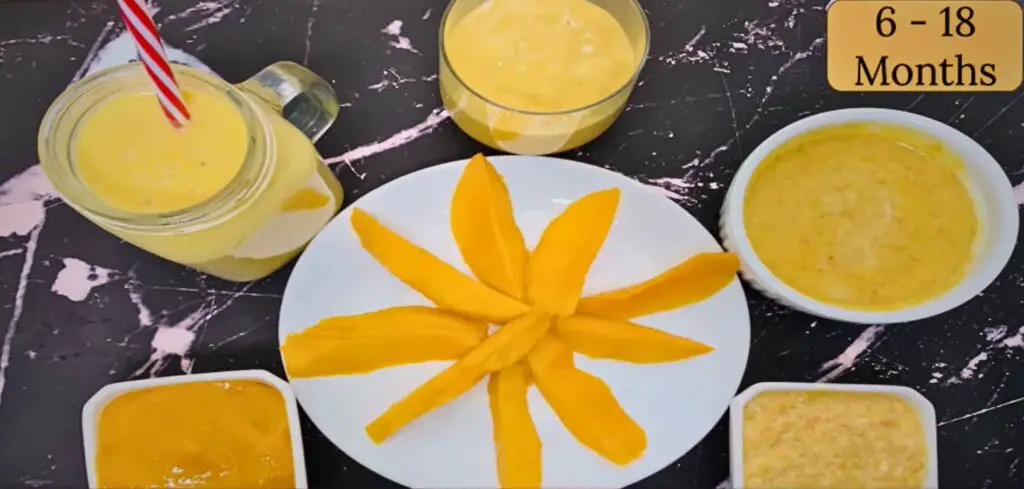
Discover a range of advanced mango baby food recipes that are easy to make at home. These recipes provide nutritious options to introduce the sweet and tropical flavors of mango to your little one’s diet.
Mango And Spinach Puree
- Purees are a great way to introduce fruits and vegetables to your baby’s diet. This mango and spinach puree is packed with essential nutrients and is easy to prepare. Here’s how you can make it:
- Start by cutting a ripe mango into small pieces and removing the skin and pit.
- Rinse a bunch of fresh spinach leaves thoroughly and chop them finely.
- Steam the chopped spinach until it becomes tender and vibrant green in color.
- Transfer the steamed spinach and mango pieces into a blender and puree until smooth.
- If necessary, add a small amount of water to achieve the desired consistency.
- Serve the mango and spinach puree immediately or refrigerate for up to three days.
This delicious puree not only introduces the taste of mango to your little one but also provides them with the goodness of spinach. The combination of these two ingredients offers a wonderful blend of vitamins, minerals, and antioxidants, supporting your baby’s growth and development.
Mango And Avocado Blend
Avocado is a nutrient-dense fruit that is often recommended for babies. Combining it with mango creates a smooth and creamy blend that your baby will love. Here’s how you can make a mango and avocado blend:
- Peel a ripe mango and remove the pit. Cut it into small pieces.
- Cut a ripe avocado in half and remove the pit. Scoop out the flesh with a spoon.
- Place the mango pieces and avocado flesh into a blender.
- Blend until smooth, adding a small amount of water if needed to reach the desired consistency.
- This mango and avocado blend can be served immediately or stored in the refrigerator for up to three days.
The combination of mango and avocado provides your baby with a rich source of healthy fats, fiber, vitamins, and minerals. This blend is not only delicious but also contributes to your baby’s brain development and overall health.
Mango And Quinoa Porridge
Quinoa is a nutritious whole grain that can be introduced to your baby’s diet. When combined with mango, it creates a tasty and wholesome porridge. Here’s how you can make mango and quinoa porridge:
- Rinse half a cup of quinoa thoroughly under running water.
- In a saucepan, combine the rinsed quinoa with one cup of water.
- Bring to a boil, then reduce the heat and simmer for about 15-20 minutes until the quinoa becomes fluffy and tender.
- Peel a ripe mango, remove the pit, and cut it into small pieces.
- Allow the cooked quinoa to cool slightly before adding the mango pieces.
- Use a fork to mash the mango and mix it into the quinoa, creating a porridge-like consistency.
- Serve the mango and quinoa porridge warm or at room temperature.
This mango and quinoa porridge introduces your baby to the unique taste and texture of quinoa while providing a good source of protein and fiber. The addition of mango adds a natural sweetness and complements the earthy flavor of the quinoa.
Storing Mango Baby Food
Learn how to store mango baby food to ensure maximum freshness and nutrition for your little one. Discover the best techniques for preserving this delicious homemade treat.
Mango baby food is not only delicious but also nutritious. To ensure its freshness and maintain its quality, proper storage is crucial. Follow these tips on refrigeration and freezing options, as well as the use of suitable storage containers.
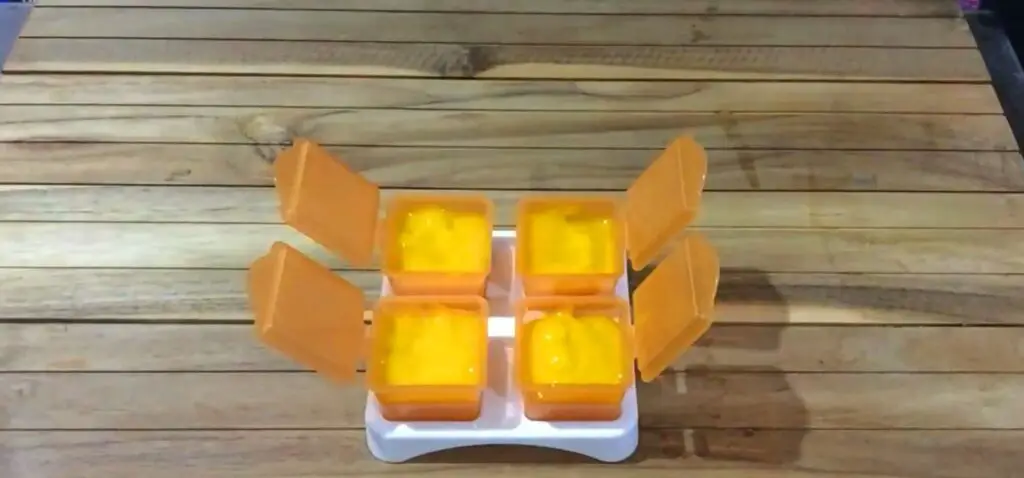
Refrigeration And Freezing Options:
- Refrigeration is the best option for short-term storage, usually up to 48 hours. This method helps preserve the freshness and nutrients of the mango baby food.
- Ensure the temperature of your refrigerator is set between 35°F and 40°F (1.5°C and 4.5°C) to maintain optimal storage conditions.
- Store the mango baby food in clean, airtight containers before placing them in the refrigerator.
- Label the containers with the date of preparation to help keep track of freshness.
Freezing, On The Other Hand, Allows For Long-Term Storage And Is Ideal If You Want To Prepare Larger Batches Of Mango Baby Food:
- Start by cooling the mango baby food in the refrigerator before freezing.
- Portion the mango puree into ice cube trays or freezer-safe containers.
- Cover the trays or containers securely with airtight lids or plastic wrap to prevent freezer burn.
- Label each portion with the date of preparation for effective rotation of frozen batches.
- Frozen mango baby food can be stored for up to three months.
Freezing allows you to have a ready supply of mango baby food whenever needed without compromising its nutritional value. Now, let’s have a look at the proper storage containers to use.
Proper Storage Containers:
When choosing containers for storing mango baby food, consider the following options:
- BPA-free plastic containers: These are lightweight, durable, and easily stackable in the refrigerator or freezer.
- Glass jars with airtight lids: Glass is a safer alternative to plastic, ensuring no unwanted chemicals leach into the food.
- Silicone trays with lids: These are perfect for portioning mango baby food into individual servings, making it convenient to defrost small amounts.
Remember to wash the containers with warm soapy water before using them for storage. Prioritize choosing containers that are easy to clean and maintain hygiene.
Proper storage of mango baby food is essential to maintain its quality, flavor, and nutrition. Follow these guidelines to ensure the freshness and safety of the food for your little one. Enjoy the convenience of having homemade mango baby food readily available while keeping their health as the top priority.
Frequently Asked Questions For How To Make Mango Baby Food
How Do You Prepare Mango For Baby?
Peel a ripe mango, remove the pit, then mash or puree it until smooth for your baby.
Is Mango Puree Safe For Babies?
Yes, mango puree is safe for babies.
Is Mango A Good Food For Babies?
Yes, mango is a good food for babies as it is rich in essential vitamins and minerals.
How To Prepare Mango For Baby-Led Weaning?
To prepare mango for baby-led weaning: 1. Choose a ripe mango and wash it thoroughly. 2. Cut the mango into small, finger-sized strips or chunks. 3. Ensure the mango pieces are soft and easy to chew for your baby. 4. Offer the mango to your baby and supervise them during mealtime to prevent choking hazards.
Conclusion
To sum up, making mango baby food is a simple and nutritious option for your little one. By following the steps outlined in this blog post, you can ensure that your homemade mango puree is safe and healthy. Remember to choose ripe mangoes, wash them thoroughly, and peel and puree them to a smooth consistency.
Introducing mangoes to your baby’s diet can provide them with essential nutrients like vitamin C and fiber. It is a versatile fruit that can be enjoyed on its own or combined with other ingredients for added flavor and variety. By making your own mango baby food, you have full control over the ingredients and can avoid added sugars and preservatives.
So go ahead and introduce your little one to the wonderful world of mangoes – you’ll both enjoy the taste and the benefits it offers.

